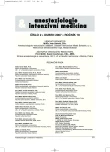The use of neuromuscular blockade in the departments of anaesthesia in the Czech Republic in 2006 – a questionnaire survey
Authors:
M. Adamus 1; T. Gabrhelík 1; O. Marek 1; J. Koutná 1; Š. Trenkler 2
Authors‘ workplace:
Klinika anesteziologie a resuscitace, Fakultní nemocnice a Lékařská fakulta Univerzity Palackého, Olomouc
1; Klinika anestéziológie a intenzívnej medicíny, Fakultná NsP Jána Adama Reimana, Prešovská univerzita
a Slovenská zdravotnícka univerzita, Prešov, Slovenská republika
2
Published in:
Anest. intenziv. Med., 18, 2007, č. 2, s. 73-84
Category:
Anaesthesiology - Original Paper
Overview
Objective:
To evaluate the use of muscle relaxants in the anaesthetic departments in the Czech Republic.
Design:
Prospective, multicentre, questionnaire, correspondence study.
Settings:
Anaesthetic departments, Czech Republic.
Material and methods:
We posted a structured questionnaire regarding the use and choice of muscle relaxants depending on the length of surgery to the heads of 140 Czech departments of anaesthesia.We were also interested in the methods and techniques of neuromuscular blockade monitoring and the dose regimens for block reversal by neostigmine. Descriptive statistics were used to analyze the results.
Results:
96% of the questionnaires returned. Nine neuromuscular blockers are currently available in the Czech Republic (suxamethonium, alcuronium, atracurium, cisatracurium, mivacurium, pancuronium, pipecuronium, rocuronium and vecuronium). Atracurium (74%), cisatracurium (41%) and vecuronium (20%) are the most preferred ones. Suxamethonium is most commonly used for patients at risk of aspiration (91%) and those with potential difficult airways (75%). A bolus dose with or without top-ups is the most frequent strategy of administration.Timing (63%) is the most commonly used special procedure followed by priming (31%) and precurarization (22%). Monitoring of neuromuscular blockade relies mainly on clinical judgement (73%), as 50% of departments do not have the monitoring equipment. This is based on expert (40%), economical (42%) and technical (25%) reasons. Neostigmine is usually administered according to clinical signs (90%). The most frequently used dose is 1.0 mg.
Conclusion:
The same muscle relaxants are used in the Czech Republic as worldwide. An initial bolus and top-ups is the most frequently used strategy for muscle relaxation. There is a noteworthy lack of monitoring facilities in Czech anaesthetic departments. A relatively small dose of neostigmine is used for reversal.
Key words:
neuromuscular blockade – neuromuscular blocker – neostigmine – monitoring – questionnaire survey
Labels
Anaesthesiology, Resuscitation and Inten Intensive Care MedicineArticle was published in
Anaesthesiology and Intensive Care Medicine

2007 Issue 2
Most read in this issue
- Oxygen toxicity in the course of hyperbaric oxygenotherapy
- Postintubation tracheal rupture – a case report
- Anaesthesiology and resuscitation in The Central Army Hospital in Prague (1948–1972)
- The benefits of BIS monitoring during sevoflurane anaesthesia in children
